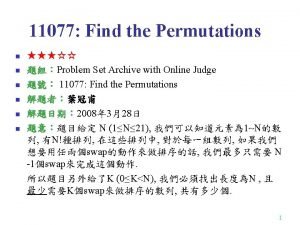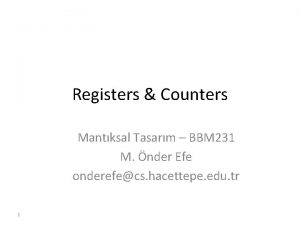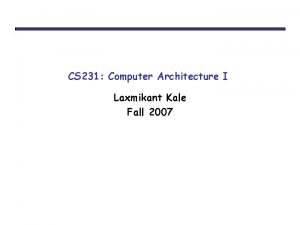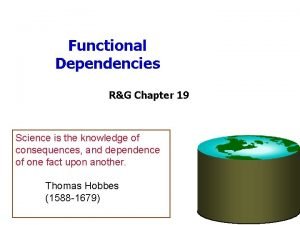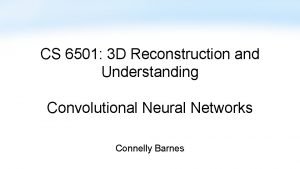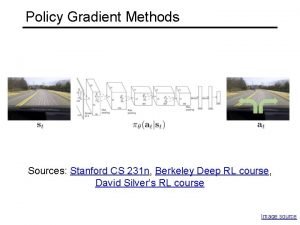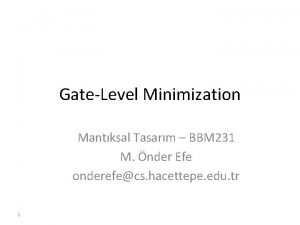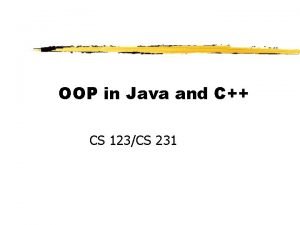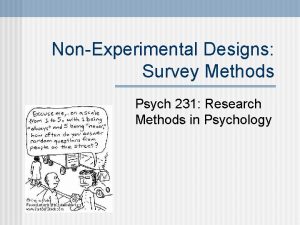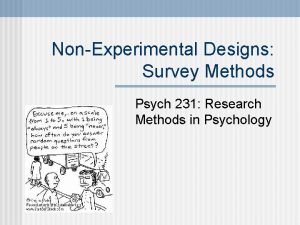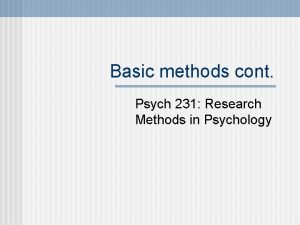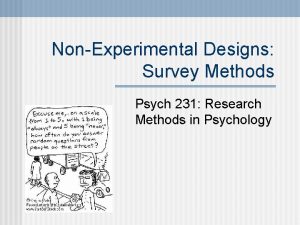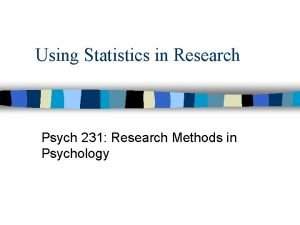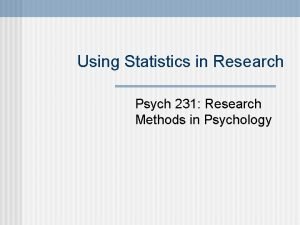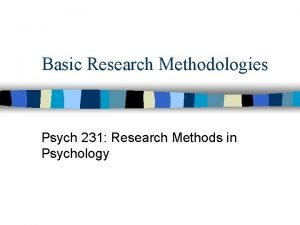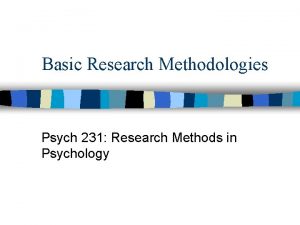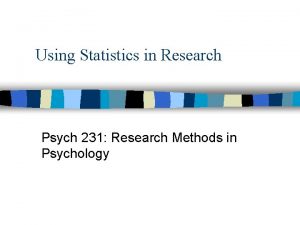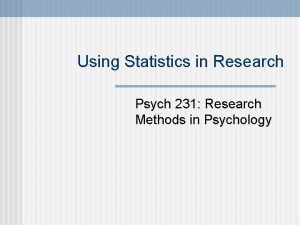The research process Psych 231 Research Methods in



















- Slides: 19

The research process Psych 231: Research Methods in Psychology

n This is the final lecture n n Wednesday (optional) – Review Q&A, help with posters, etc. Labs this week n n n Poster presentations Turn in group ratings sheets Turn in results and reference section for group project Announcements

n Cross-sectional design n Study groups of individuals of different ages at the same time • Age is subject variable treated as a between-subjects variable n Age 4 Age 7 Age 11 Longitudinal design n Follow the same individual or group over time • Age is treated as a within-subjects variable time Age 11 Age 15 Age 20 Developmental designs

n Cohort-sequential design n Measure groups of participants as they age • Example: measure a group of 5 year olds, then the same group 10 years later, as well as another group of 5 year olds n Age is both between and within subjects variable • Combines elements of cross-sectional and longitudinal designs • Addresses some of the concerns raised by other designs • For example, allows to evaluate the contribution of cohort effects Developmental designs

n Cohort-sequential design Cross-sectional component Time of measurement 1975 Cohort A 1970 s Cohort B 1980 s Cohort C 1990 s Age 5 1985 1995 Age 15 Age 25 Age 15 Age 5 Longitudinal component Developmental designs

n Cohort-sequential design n Advantages: • Get more information • Can track developmental changes to individuals • Can compare different ages at a single time • Can measure generation effect • Less time-consuming than longitudinal (sort of) • Can examine age comparisons along the way n Disadvantages: • Still time-consuming • Need lots of groups of participants • Still cannot make causal claims (about the age variable) Developmental designs

Presenting your work Get an idea § § § A set of skills leading to knowledge & understanding A way of thinking (beware small samples, correlation is not causation, etc. ) A way of life? Stats. org: Stats in the news Course Review: The Research Process

§ Get an idea – – Often the hardest part No firm rules for how to do this – – Observations Past research – Review the literature The Research Process

n Review the literature n What has already been done? • What variables have people looked at • What hasn’t been looked at n n How are other experiments in the area done? What methods are used? • To measure the dependent variable • To manipulate the independent variable • To control extraneous variables The Research Process

§ Formulate a testable hypothesis – What is a hypothesis? – – A predicted relationship between variables What does it mean to be testable? – – – Must be falsifiable Can it be replicated Must be able to observe/measure (and manipulate for experiments) the variables – – – Directly Indirectly Operational definitions The Research Process

n Design the research – – What method? – What kind of comparisons are used – – – Control groups Baseline conditions What are your variables? – – – Experiment, Survey, Developmental designs, … How many levels of your Independent variable(s) How do you measure your dependent variable(s) What can be done to control for biases and confounds? The Research Process

n Collect Data n n Importance of pilot research Who do you test? • What is your population? • Your sample? • Your sampling method? The Research Process

n Analyze the data n n Design drives the statistics Understanding Variables and variability • Descriptive statistics (summarizing) • Means, standard deviations • Graphs, tables • Correlation • Inferential statistics (drawing conclusions) • • What kind of analysis is appropriate for your design T-tests ANOVA Between or within versions The Research Process

n Interpret the results n n n Correlation versus causation Reject or fail to reject null hypotheses Statistical vs. theoretical significance Support or refute theory (or revise) Generalizability of the results The Research Process

n Present the results n Getting the research “out there” • Conference presentations • Posters • Talks • Written reports • APA style • Supports clarity The Research Process

n Repeat n Each set of results leads to more research questions • Refine theory • Test a refined theory • Test alternative explanations The Research Process

n Wed Dec. 14 1: 00 -2: 50 n It is cumulative, covers the entire course. The majority is on new material (roughly 65%), the rest is material covered on Exams 1 & 2. All multiple choice/scantron for the final n Reviewing for the final exam

n n Final 1/3 of the course Non experimental methods n Survey, correlational, & developmental Statistics n Descriptive n Inferential Presentations n Papers, Posters, & Talks Reviewing for the final exam

n First 2/3 of the course § Scientific method n § § § § n Getting ideas Developing (good) theories Reviewing the literature Psychological Science Ethics Basic methodologies APA style § Underlying reasons for the organization § Parts of a manuscript n n Variables Sampling Control Experimental Designs n n Vocabulary Single factor designs Between & Within Factorial designs Reviewing for the final exam
 Process of business research methods
Process of business research methods A-wax pattern recognition
A-wax pattern recognition Acf 231
Acf 231 Article 231 of the treaty of versailles
Article 231 of the treaty of versailles 123+132+321+312
123+132+321+312 Phy 231 msu
Phy 231 msu Dlgs 231 2007
Dlgs 231 2007 Natal natal é vindo ao mundo o rei divinal
Natal natal é vindo ao mundo o rei divinal Gezang 231
Gezang 231 Application of shift register
Application of shift register Cs231
Cs231 Cost 231 walfisch-ikegami model
Cost 231 walfisch-ikegami model Draw 231 with base ten blocks
Draw 231 with base ten blocks 040 231 3666
040 231 3666 Mvcnn pytorch
Mvcnn pytorch Stanford 231n
Stanford 231n Bbm 231
Bbm 231 Pengertian berjiran
Pengertian berjiran Artical 231
Artical 231 123cs
123cs




